How to Grow Thyme

Thyme
Quick links to save you time
Why Grow Thyme? I'll give you 8 reasons
- It is easy to grow: Thyme is a low-maintenance herb that doesn’t require much care. It is cold-hardy, drought-tolerant, and can grow in poor soil conditions.
- Thyme has medicinal properties: People have used it for centuries for its medicinal properties. It is an antiviral herb that can help with common cold symptoms, coughs, and bronchial infections. It is also a potent antiseptic for cuts, scrapes, acne, or sore muscles.
- It acts as a pest repellent: Thyme’s strong scent confuses pests looking for their favorite crops to devour. Planting thyme around the perimeter of the vegetable garden and underneath fruit trees can help keep pests away.
- Thyme attracts pollinators: Thyme’s tiny flowers draw a diverse group of helpful insects, such as native pollinators, honeybees, and predatory wasps. Planting thyme in the garden can help increase the yields of all your fruits and vegetables.
- It has many culinary uses: Thyme is a multipurpose herb good for many dishes, from soups and sauces to meats and beans. It pairs well with savory flavors and can be used fresh or dried.
- It helps with soil erosion control: Thyme thrives in dry and rocky areas and can help with soil erosion. It is excellent to grow in a pot, either outdoors or in a sunny windowsill.
- Thyme is good for aromatherapy: Thyme’s essential oil boosts mood and relieves stress.
- It is rich in nutrients: Thyme is high in iron and antioxidants, and it contains vitamins A and C, copper, fiber, iron, and manganese.
Thyme in Landscaping

Flowering Thyme by suika
- Ground cover: Thyme is a low-growing herb that is excellent as a ground cover in landscaping. It is suitable for any dry, well-drained spot, such as patios, walks, rock gardens, stone walls, or pond borders. Thyme plants cascade, drape, and mound in soft mats, making them an excellent choice for rock gardens, walls, and rocky slopes. This plant is always at home in rock gardens, walls, and on rocky slopes. It will meander down crevices, cascade over boulders, or form tight, sculptural mounds.
- Edging: Thyme can be an edging plant to define garden beds or walkways. It is an excellent alternative to traditional edging plants like boxwood or holly, adding a fragrant touch to the garden.
- Pollinator attractor: Thyme’s little flowers attract various beneficial insects. Planting thyme in the garden can help increase the yields of all your fruits and vegetables.
- Pest repellent: Thyme’s strong scent confuses pests. Planting thyme around the perimeter of the vegetable garden and underneath fruit trees can help keep pests away.
- Soil erosion control: Thyme thrives in dry and rocky areas and can help with soil erosion.
- Durability: Thyme is a resilient perennial herb that thrives even in harsh weather conditions, making it an excellent choice for landscaping.
- Color and fragrance: Thyme is suitable for many gardens and has various colors and scents. Some varieties have silver or variegated leaves, while others have pink or purple flowers. Its fragrance can range from lemony to spicy to earthy.
10 Varieties of Thyme

Common Thyme
Some varieties in this list are regional versions of common thyme, like French, Spanish, Greek, or Za’atar (Middle Eastern) thyme. I included some of them here, because people might know them by these names due to cultural or commercial reasons.
- Common Thyme (Thymus vulgaris): This is the most well-known type of thyme, offering many varieties. Common Thyme can reach a height of 15 to 40cm (up to 1 meter) and grows upright with woody shoots. The small leaves are green to grey-green, and Common thyme, based on the variety, produces purple, pink, or white flowers.

Lemon Thyme
Credit Alberto Conde, Kitchen in the Med
- Lemon Thyme (Thymus citriodorus): This is an ornamental species with an herbal citrus scent. Its wee oval green leaves grow in opposite pairs on each stem, and flowers grow in itty-bitty clusters of lilac, pinkish-purple, magenta, or, more rarely, white blooms. Lemon Thyme is a low-growing, mat-forming thyme with golden and variegated silver foliage available. It is very common in the Mediterranean, and prevalent in Spain, where I am from.

Caraway Thyme, Thymus “Herba Barona”
- Caraway Thyme (Thymus herba-barona): This edible and ornamental species smells like caraway, thanks to the carvone terpenoids it contains. The leaves are long, pointed ovals, dark green and glossy, on reddish stems. In late spring through summer, caraway thyme produces pink flowers, charming local butterflies, and bees with its rich nectar.

Creeping Red Thyme
Credit Alberto Conde, Kitchen in the Med
- Creeping Thyme (Thymus serpyllum): This mat-forming Thyme grows only 2 to 3 inches or up to 7.5 cm tall and mauve, white, and crimson flowering cultivars are available. Its form makes it a fantastic ground cover. The low branches create filler between stones, and its wild habit also allows it to sprawl over rocks.

Woolly Thyme in Bloom
- Woolly Thyme (Thymus pseudolanuginosus) is a low-growing, spreading plant with hairy leaves and stems. The white hairs that sparsely cover the surface give this ornamental a surreal, soft, furry aesthetic. Woolly thyme grows in dense cushions of broad mats, and pale pink flowers bloom in early summer.

French Thyme (Thymus Vulgaris)
- French Thyme (Thymus vulgaris’ French’) is a more delicate common thyme. It is another fairly standard variety of the herb, with exceedingly narrow leaves and an overall sweeter taste than traditional common thyme.

Spicy Orange Thyme
- Orange Thyme (Thymus fragrantissimus): This unusually low-growing, ground-cover Thyme smells like orange. It is an excellent addition to any garden and works well in cooking.
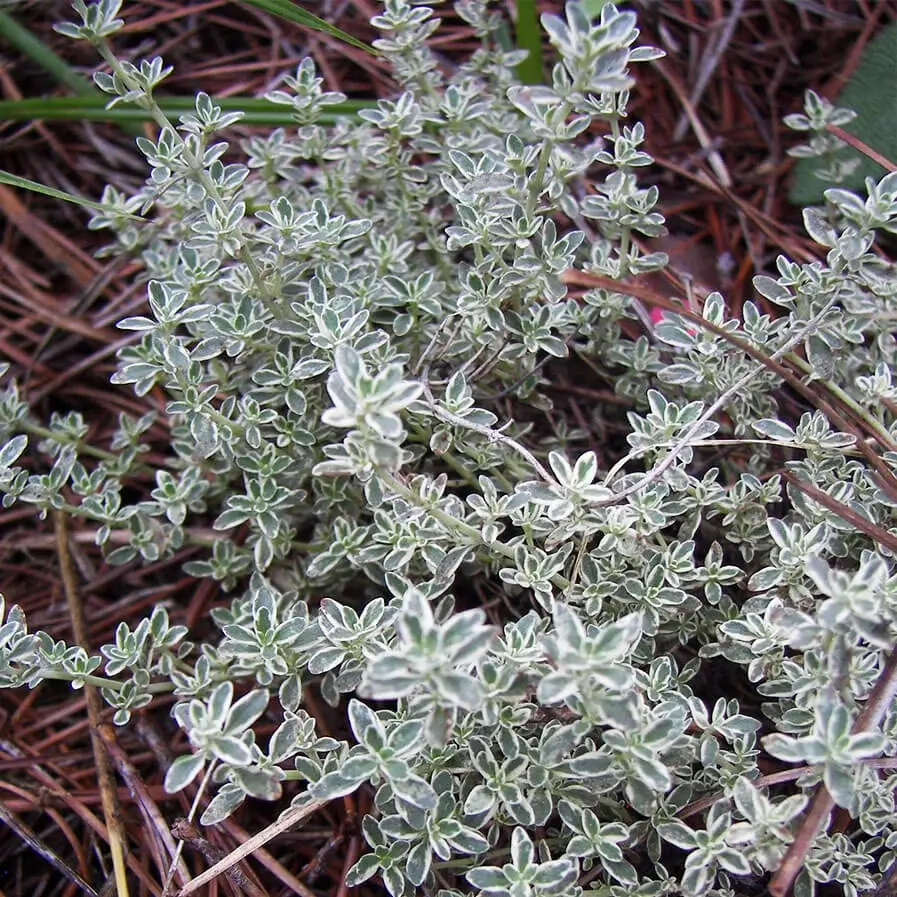
Silver Thyme (Thymus Vulgaris Argenteus)
- Silver Thyme (Thymus vulgaris’ Argenteus’): is a white/cream variegated cultivar. It is an excellent addition to any garden and even in cooking.

Thymus Pulegioides
- Broad-leaved Thyme (Thymus pulegioides): This dwarf shrub can grow up to 10 inches or 25cm high. Its leaves’ high essential oil content gives them a strong aroma, which is why many choose it for culinary and medicinal purposes. Between June and August, it bears delicate red to purple flowers.

Common Thyme
- Za’atar Thyme (Thymus vulgaris): This is a Middle Eastern variety of thyme used in cooking. It has a unique flavor and is common in spice blends.
How to How to Grow Thyme in Gardens and Containers

Creeping Purple Thyme
You can grow it in both, but consider the different requirements.
Growing Thyme in Gardens:
- Choose the right location: Thyme grows best in a sunny place with well-drained soil. It tolerates drought conditions, making it an excellent choice for gardens facing water shortages.
- Planting: Thyme can be planted as a perennial in Hardiness Zones 5-9 or as an annual in other zones. Space young plants about 10-12 inches apart. Dig a hole and place transplants at the same depth as in the container. Thyme grows well in the herb garden along with other culinary herbs, vegetable beds, raised beds, and as a low-growing shrub in perennial gardens.
- Soil: Thyme grows best in a fertile, well-draining soil, like sandy loam. Avoid soil with too much water, like clayey soil, because thyme roots tend to rot.
- Watering: Thyme plants don’t like wet soils, so provide good drainage to keep roots from rotting. Water only when the soil is dry.
- Companion planting: Thyme flourishes in sunlight. When planting thyme in containers, pair it with rosemary since they share similar watering requirements. Position it next to the garden’s strawberries, tomatoes, and other vegetables.

Lemon Thyme in a Container
Credit Alberto Conde, Kitchen in the Med
Growing Thyme in Containers:
- Choose the suitable container: Thyme is a slow grower with superficial roots. To grow a great plant, you need a pot 6 inches deep and 12 inches (15-30 cm) in diameter. Terracotta pots are lovely, letting roots breathe, but any container allowing water to flow through will work nicely.
- Soil: Thyme naturally grows in stony soils and requires good drainage. If your pot doesn’t have drainage holes, drill them yourself. Thyme works well in raised beds with companion herbs like oregano, rosemary, lavender, and sage. They all appreciate similar soil draining conditions, so add horticultural sand or perlite if the raised bed contains heavy soil.
- Planting: Most gardeners opt to purchase a nursery start, which you can later propagate via cuttings. Prepare the soil and plant your thyme about 12 inches or around 30 cm from other herbs so it has room to spread.
- Watering: Once established, thyme is drought tolerant and ideal for arid climates and water-wise gardens. Check small transplants often and water them whenever the soil is dry.
- Companion planting: As we have already seen, thyme needs sunlight. In containers, pair it with rosemary since they share similar watering requirements. Position it next to the garden’s strawberries, tomatoes, and other vegetables.
10 Tips to Remember for Growing Thyme

Thyme Allegory
Credit Alberto Conde, Kitchen in the Med
- Choose the suitable variety: There are nearly 200 different thyme varieties, so select the one that best suits your needs. Certain thyme varieties excel when planted in gravel gardens, within paving gaps, or as lawn substitutes, while some prefer growing in pots.
- Cut back after flowering: Cut it back to encourage fresh growth after thyme completes flowering. This action ensures you have ample leaves to collect throughout the fall.
- Protect tender species in winter: Thyme is essentially drought-loving but needs protection from cold winds and wet winters. If you live in an area with harsh winters, consider growing thyme in containers you can bring indoors in autumn.
- Use companion planting: As mentioned before, plant it with other plants requiring lots of sun. If you use a container, it is best to accompany thyme with other plants with similar low water needs. If you plant it in the garden, place it next to vegetables to help improve their growth and flavor.
- Propagate by layering: Secure a lengthy thyme stem to the soil using wire or a U-shaped stake, ensuring only the last four inches of the tip remain loose. The pinned part should touch the ground directly. In about a month, this stem will begin rooting. Once rooted, separate the new plant from the main one and relocate it to another garden spot or a sizable pot.
- Begin growing thyme from seed indoors: You can start growing thyme from seed indoors or directly in the ground outdoors after the last frost. Thyme grown from seed may take a year or so to get established enough for you to start harvesting the leaves.
- Spacing: Thyme needs space because it is a robust grower. Plant anywhere from 12 to 24 inches (30 to 61 cm) apart, depending upon the specific variety.
- Feeding: Thyme grows best in poor soil and needs no additional feeding. In the early spring, you can feed compost or other organic materials, but thyme doesn’t require significant soil amendments.
- Watering: It is best to wait until the ground is dry before watering thyme. If you’re growing it in containers, water when the soil’s top inch feels dry when you touch it.
- Soil: Place thyme in soil that drains well and has a pH of 6.0 to 8.0. If your soil is heavy or damp, especially in winter, plant Thyme in containers or raised beds with a quality potting mix.
10 Points on How to Grow Thyme from Cuttings

Thyme Cuttings
- Choose Healthy Parent Plants: Select a robust and healthy thyme plant from which to take cuttings. Avoid plants showing signs of disease or stress.
- Take Cuttings Properly: Use sharp, clean scissors or shears to cut a 4-6 inch (11-15 cm) stem from the parent plant. Cut just below a leaf node.
- Remove Lower Leaves: Discard the leaves from the lower half of the cutting. It helps the cutting focus its energy on root development.
- Prepare Rooting Medium: Use a well-draining soil mix or a combination of sand and perlite. Ensure it is slightly moist but not soggy.
- Dip in Rooting Hormone: For better rooting success, dip the cut end of the stem in a rooting hormone powder. This step is optional but can improve results.
- Plant the Cuttings: Set the cuttings into the soil, burying the stripped part of the stem. If planting multiple cuttings in one container, space the cuttings about 2 inches or 5 cm apart.
- Provide Indirect Light: Put the container in a place with bright, indirect light. Avoid full sunlight, which can stress the cuttings.
- Maintain Humidity: Cover the container with a clear plastic bag or dome to create a humid environment. It helps prevent the cuttings from drying out.
- Water Sparingly: Keep the soil consistently moist but not soggy. Water the cuttings lightly and regularly to maintain moisture without waterlogging the soil.
- Transplant When Rooted: The cuttings should develop roots after 4-6 weeks. Very gently pull on the cuttings; if you feel resistance, they have rooted. Transplant the rooted cuttings into individual pots or directly into the garden.
Is Thyme safe for pets?

Thyme Cuttings
According to the ASPCA (American Society for the Prevention of Cruelty to Animals), thyme is non-toxic to dogs, cats, and horses.
Thyme offers pets valuable dietary fiber, antioxidants, vitamins A and C, riboflavin, calcium, iron, magnesium, selenium, and manganese.
Feeding your pets with the right amount of thyme can help inhibit fungal and bacterial growth, support their immune system, improve their digestive health, and remove hairballs from their digestive tract.
However, it is crucial to ensure your pets don’t consume excessive amounts of thyme, as large quantities could lead to digestive upset.
If you’re considering using or giving thyme oil to your pets, remember to consult your veterinarian first.
9 Common Mistakes When Growing Thyme
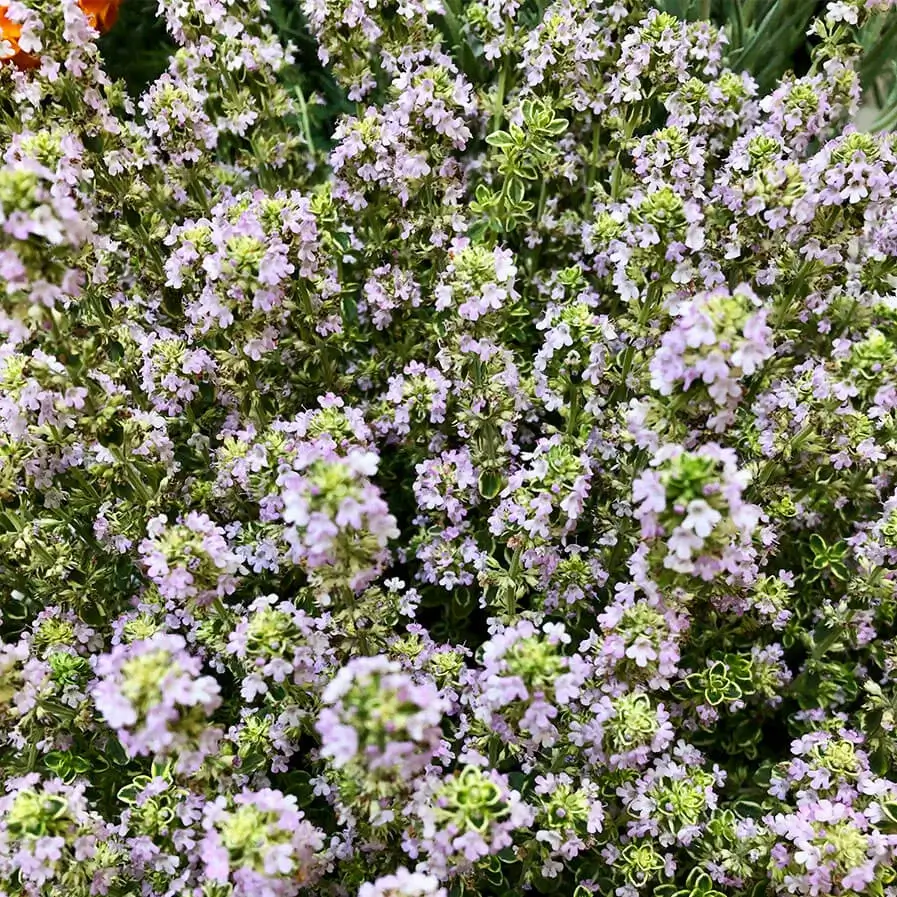
Lemon Thyme
Credit Alberto Conde, Kitchen in the Med
- Overwatering: Thyme thrives in well-drained soil and is not fond of excessive moisture. Overwatering can lead to a severe issue: root rot. It is critical to let the soil dry out between waterings.
- Poor Soil Drainage: Thyme needs sandy or loamy soil with excellent drainage. Heavy, clay soils can suffocate roots. Amend soil with sand or perlite to improve drainage.
- Insufficient Sunlight: Thyme requires full sun, at least 6-8 hours daily. Place it in a sunny spot to ensure robust growth and flavor development.
- Over-fertilizing: Thyme prefers lean soil and doesn’t need much fertilizer. Over-fertilizing can lead to leggy growth and reduced flavor. Use compost sparingly.
- Crowding Plants: Thyme needs good air circulation to prevent fungal diseases. Depending on the variety, place the plants 12-24 inches or 30-60 cm apart to allow air to flow around them.
- Neglecting Pruning: Regular pruning encourages bushy growth and prevents the plant from becoming woody. Trim thyme after it flowers and periodically harvest stems.
- Ignoring Pests and Diseases: Although thyme resists pests, aphids, spider mites, and fungal diseases can still cause problems. Inspect plants regularly and treat issues promptly.
- Incorrect Harvesting: Harvest thyme by cutting stems, not pulling them out. Pulling can damage the plant. Always use clean, sharp pruning shears.
- Improper Winter Care: Thyme can withstand cold but needs protection in harsh winters. Mulch around the base of the plant or bring potted thyme indoors.
Is Pruning Thyme Necessary?
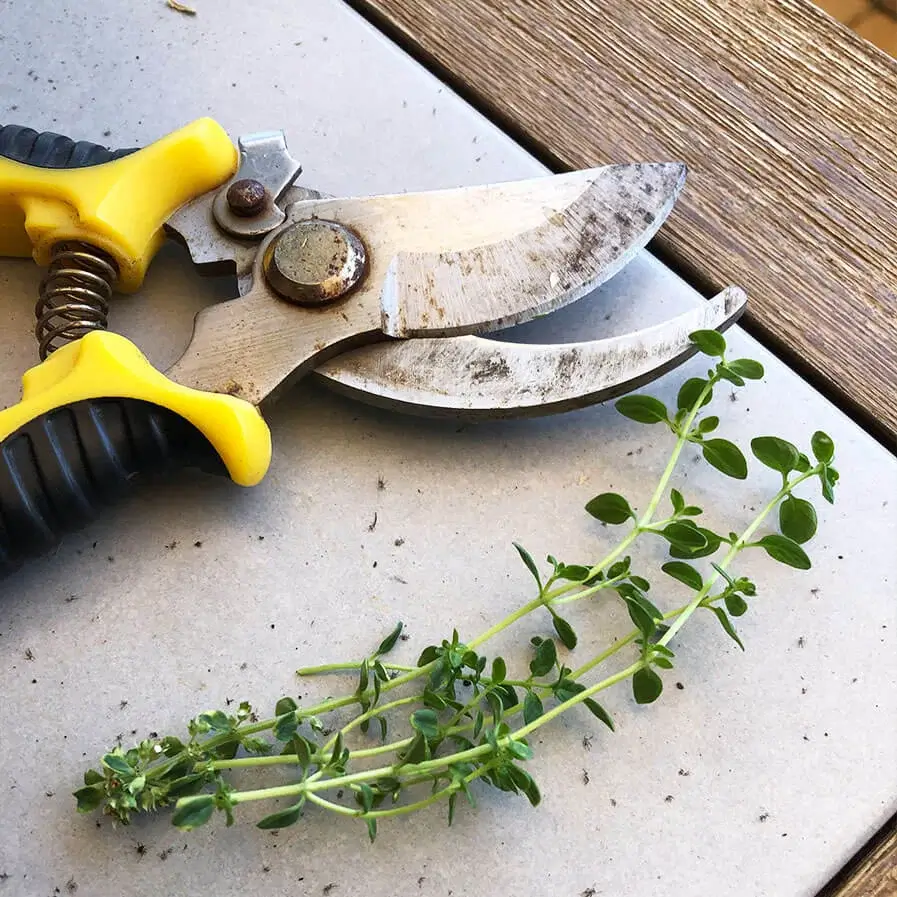
Pruning Thyme
Credit Alberto Conde, Kitchen in the Med
Yes, pruning thyme is necessary for several reasons:
- Encourages Bushy Growth: Regular pruning helps thyme plants develop a denser, bushier form and prevents them from becoming leggy and woody.
- Prolongs Plant Life: Trimming back old, woody stems stimulates new growth. It keeps the plant vigorous and extends its productive life.
- Enhances Flavor: Pruning thyme encourages the growth of new, tender stems and leaves, which have better flavor and aroma than older, woody parts.
- Promotes Air Circulation: Regularly pruning thyme improves air circulation around the plant, reducing the risk of fungal diseases.
- Prevents Flowering: If you don’t want your thyme to flower (as flowering can sometimes reduce the potency of the leaves), pruning can prevent this by removing flower buds before they open.
- Aesthetic Maintenance: Pruning keeps the plant tidy and well-shaped, making it more attractive in the garden.

Thymus Vulgaris (Common Thyme)
When and How to Prune Thyme
Prune thyme in early spring, just as new growth begins. This timing ensures the plant recovers quickly and promotes healthy, vigorous growth throughout the season.
Here are critical steps to prune thyme effectively:
- Remove Dead or Damaged Stems: Remove any dead, damaged, or woody stems to encourage new growth and maintain plant health.
- Shape the Plant: Trim back stems to shape the plant and keep it compact. It deters the plant from becoming leggy and promotes a fuller appearance.
- Harvest Regularly: Pinch or snip fresh growth regularly throughout the growing season. This provides fresh thyme for cooking and encourages the plant to produce more new growth.
Can You Prune Thyme Excessively?
Yes, you can prune thyme excessively, and doing so can harm the plant. Here’s how to avoid over-pruning:
- Avoid Cutting Too Much at Once: Do not remove more than one-third of the plant at a time. Taking too much can stress the plant and hinder its ability to photosynthesize effectively.
- Don’t Prune Down to Woody Stems: Thyme plants have a woody base. Pruning too far into this woody part can damage the plant and inhibit new growth. Focus on trimming the green, leafy sections.
- Allow Recovery Time: After a significant pruning, give the plant time to recover before cutting it again. It helps maintain plant health and vigor.
- Regular, Light Pruning: Opt for regular, light trimming instead of infrequent heavy pruning. Harvest stems frequently to promote continuous growth and maintain shape.
Here is a recap of the 10 tips to Grow the Best Thyme Now

Thyme
- Ensure Proper Drainage: Plant thyme in well-drained soil. To improve drainage, amend heavy clay soils with sand or perlite.
- Provide Full Sunlight: To encourage healthy development, select a spot that receives at least 6-8 hours of full sunlight daily.
- Water Sparingly: Let the soil dry out before you water the plant. Overwatering may produce root rot, so water thyme moderately.
- Use Lean Soil: Thyme prefers poor, sandy, or loamy soil. Avoid over-fertilizing, as rich soil can cause leggy growth and reduce flavor.
- Space Plants Properly: Plant thyme 12-24 inches apart to provide adequate air circulation and avert fungal diseases.
- Prune Regularly: Trim thyme after it flowers and periodically harvest stems to encourage bushy growth and prevent the plant from becoming woody.
- Inspect for Pests and Diseases: Regularly check thyme plants for aphids, spider mites, and fungal diseases. Treat any issues promptly.
- Harvest Correctly: Use clean, sharp scissors or pruning shears to cut stems. Avoid pulling them out to prevent plant damage.
- Mulch in Winter: Provide some protection in rough winters by mulching about the base of the plant or placing potted thyme indoors.
- Rotate Locations: Rotate where you plant thyme every few years to prevent soil depletion and reduce pest and disease buildup.
Troubleshooting Thyme: Growing Problems, Pests, and Diseases

Leggy Thyme
Common Growing Problems
- Poor Soil Drainage
Problem: Thyme roots can rot if the soil retains too much water.
Solution: Plant thyme in well-draining soil. Add sand or gravel to improve drainage.
- Overwatering
Problem: Overwatering can lead to root rot and fungal diseases.
Solution: Water thyme sparingly. Let the soil dry out between waterings.
- Underwatering
Problem: Thyme can wilt or die if it doesn’t receive enough water, especially in hot climates.
Solution: Water thyme regularly, but avoid soaking the soil. Aim for a balance that keeps the soil slightly moist.
- Lack of Sunlight
Problem: Thyme requires full sun to thrive.
Solution: Plant thyme in a location where it receives at least 6-8 hours of direct sunlight daily.
- Pests
Problem: Aphids, spider mites, and whiteflies can attack thyme. Read more about pests in the section below.
Solution: Use insecticidal soap or neem oil to control pests. Regularly inspect plants and remove any pests by hand.
- Fungal Diseases
Problem: Fungal diseases like powdery mildew can affect thyme, especially in humid conditions. Read more about diseases in the section below.
Solution:
- Ensure good air circulation around the plants.
- Water at the base to keep foliage dry.
- Use fungicidal sprays if necessary.
- Poor Growth
Problem: Thyme might grow poorly due to nutrient deficiencies.
Solution: Although thyme doesn’t need much fertilizer, occasional feeding with a balanced, all-purpose fertilizer can boost growth.
- Legginess
Problem: Thyme can become leggy and sparse if not pruned.
Solution: Prune thyme regularly to encourage bushier growth. Remove woody stems and trim back after flowering.
- Soil pH Imbalance
Problem: Thyme prefers slightly alkaline to neutral soil pH.
Solution: Test the soil pH and amend it if necessary. If the soil is overly acidic, add lime to increase the pH.
- Frost Damage
Problem: Thyme is susceptible to frost, especially in younger plants.
Solution: Protect thyme from frost by covering it with a cloche or moving potted thyme indoors during cold snaps.

Thyme Prunnings
Thyme Diseases and Pests
Thyme is naturally resistant to pests and diseases, but there are some issues to watch out for. To prevent these issues, it is vital to Plant Thyme in well-draining soil, not overwater, and provide good air circulation. You can also use companion planting to help deter pests and improve growth. If you spot pests or diseases, catch and treat them quickly to prevent further damage.
Here’s a list of typical pests and ailments you should watch out for:
Pests:
- Aphids: These tiny insects often cluster beneath leaves or at stem tips, harming plants by drawing out their sap and transmitting diseases via their saliva.
- Spider mites: These pests can cause fine webbing on the leaves and suck the juices out of your plants. You can control them in the same manner as aphids.

Spider Mite
Diseases:
- Alternaria blight: This fungal infection causes small, circular spots in shades of yellow, brown, or black with ring patterns. It initially appears on the lower, less exposed leaves. It can cause holes in leaves, which dry out and drop, eventually leading to the plant’s death.
- Botrytis rot: Some people also call it gray mold. This fungal disease attacks thyme and other herbs during high-humidity seasons. It might appear as a hazy gray mass of decay.
- Root rot: This fungal disease can cause mushy roots and dieback.
General Tips
- Regular Inspections: Check plants frequently for signs of pests or diseases.
- Proper Spacing: Ensure adequate spacing for air circulation to reduce fungal issues.
- Healthy Practices: Use clean tools, avoid overhead watering, and mulch properly to retain soil moisture without waterlogging.
10 Great Plants to Place next to Thyme

Blueberry Bush
Blueberries (Vaccinium corymbosum)
Blueberries and Thyme are both acid-loving plants that prefer well-draining soil. Thyme can act as a pest deterrent for blueberries.
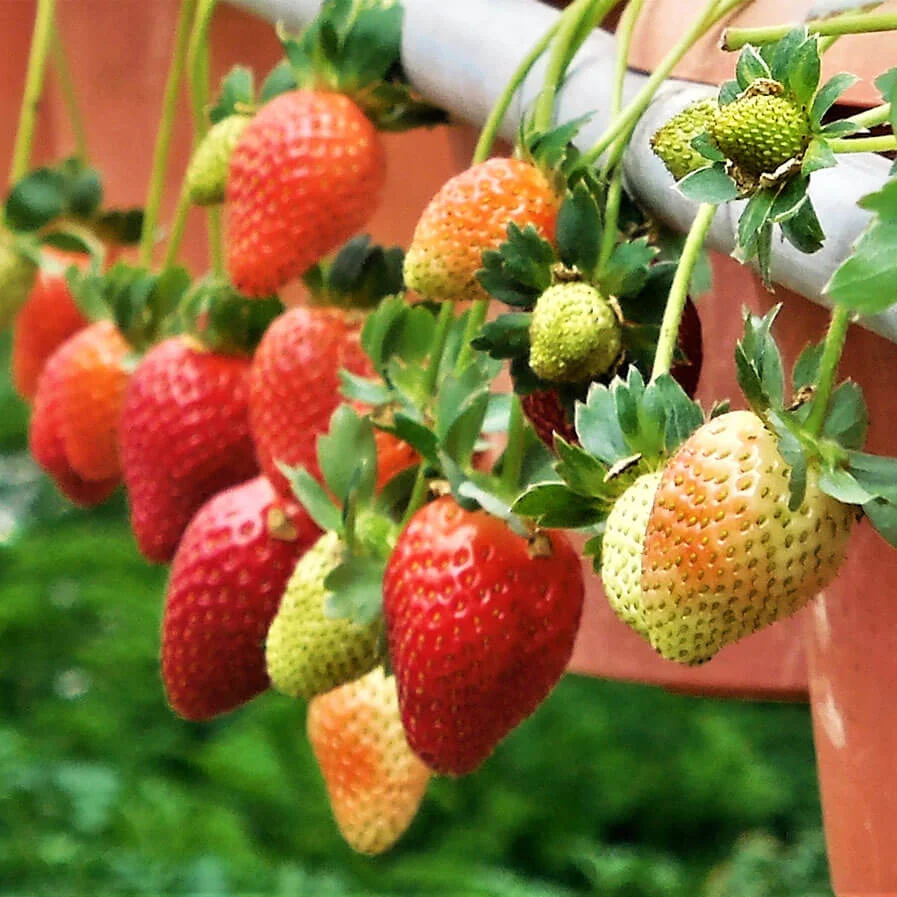
Strawberries
Strawberries (Fragaria × ananassa)
Strawberries and Thyme are both low-growing plants that prefer well-draining soil. Thyme can help deter pests that disturb strawberries.

Rosemary
Credit Alberto Conde, Kitchen in the Med
Rosemary (Rosmarinus Officinalis)
Rosemary and Thyme are Mediterranean herbs that thrive in similar growing conditions. They also have similar watering needs and can help deter pests when grown together.

Potato Plants
Potatoes (Solanum tuberosum)
Potatoes and Thyme are both low-maintenance plants that prefer well-draining soil. Thyme can help repel pests that disturb potatoes.

Heirloom Tomatoes
Tomatoes (Solanum lycopersicum)
Tomatoes and Thyme are Mediterranean plants that prefer well-draining soil and full sun. They can also help deter pests when grown together.

Sweet Marjoram
Marjoram (Origanum majorana)
Marjoram and Thyme are both members of the mint family and have similar growing requirements. When grown together, they can also help prevent pests.
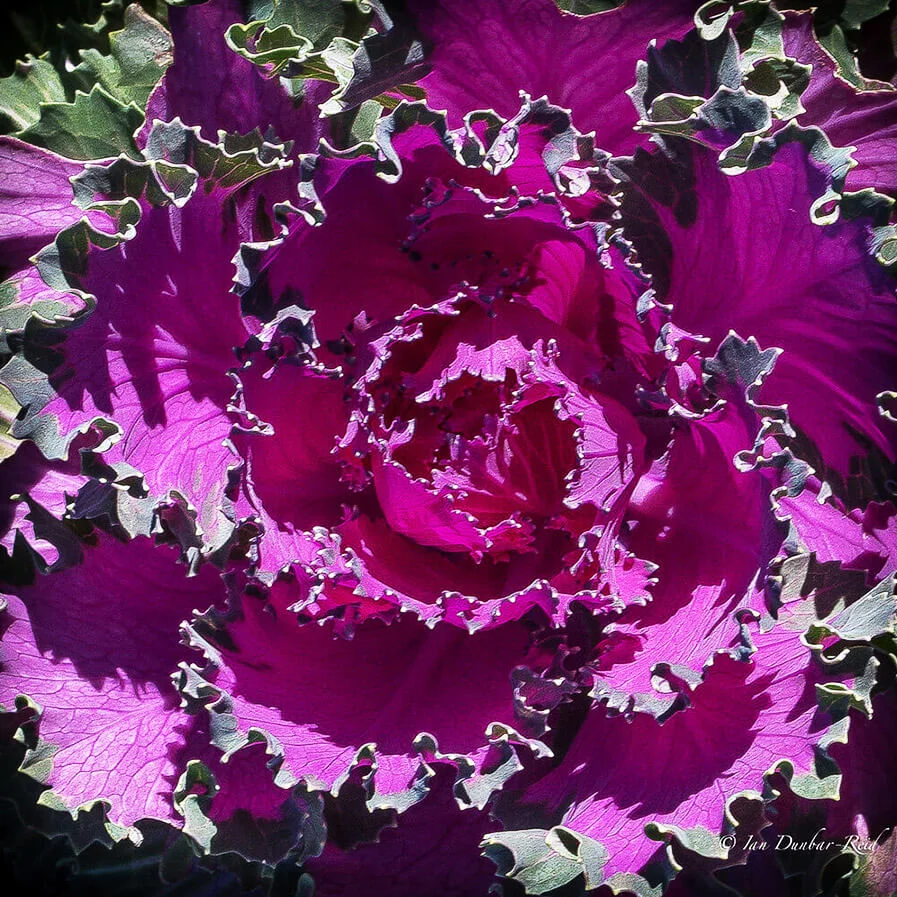
Ortnamental Brassica
Brassicas (Brassica oleracea)
Thyme can help fend off many pest insects while also luring ladybugs, a natural predator of aphids. Brassica plants like broccoli, Brussels sprouts, cabbage, cauliflower, and kohlrabi are great companion plants for thyme.

Sage (Salvia officinalis)
Sage and Thyme are both drought-tolerant and prefer well-draining soil. They also have similar watering needs and can help prevent pests when grown together.

Oregano
Oregano (Origanum vulgare)
Oregano and Thyme are both members of the mint family and have similar growing requirements. When grown together, they can also help deter pests.

Lavender
Lavender (Lavandula angustifolia, stoechas, dentata)
Lavender and Thyme are both drought-tolerant and prefer well-draining soil. These plants also attract helpful insects, such as bees and butterflies.
10 plants to avoid planting next to thyme
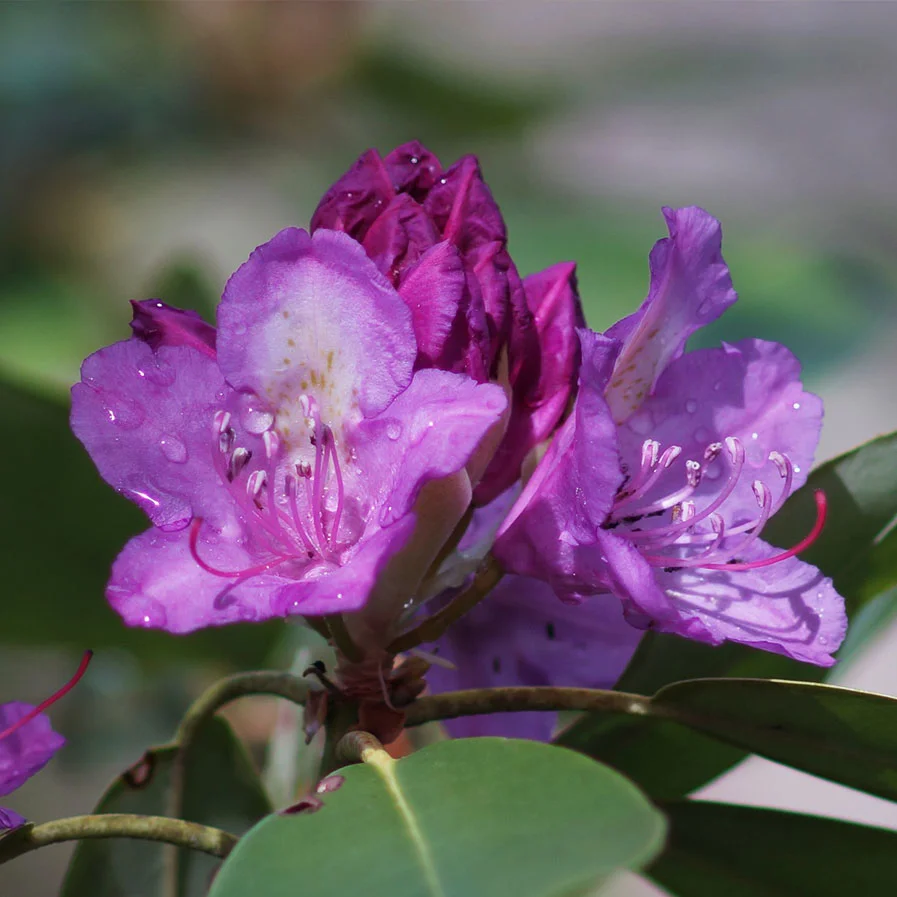
Rhododendron
- Cilantro.
- Basil.
- Chives.
- Parsley.
- Dill.
- Fennel.
- Mint. These seven plants have distinct growth needs from thyme and might compete for the same soil nutrients.
- Hydrangea.
- Azaleas and Rhododendrons.
- Maples.
The last three plants produce abundant sap that can harm the plant if it contacts thyme.
Other plants similar to thyme
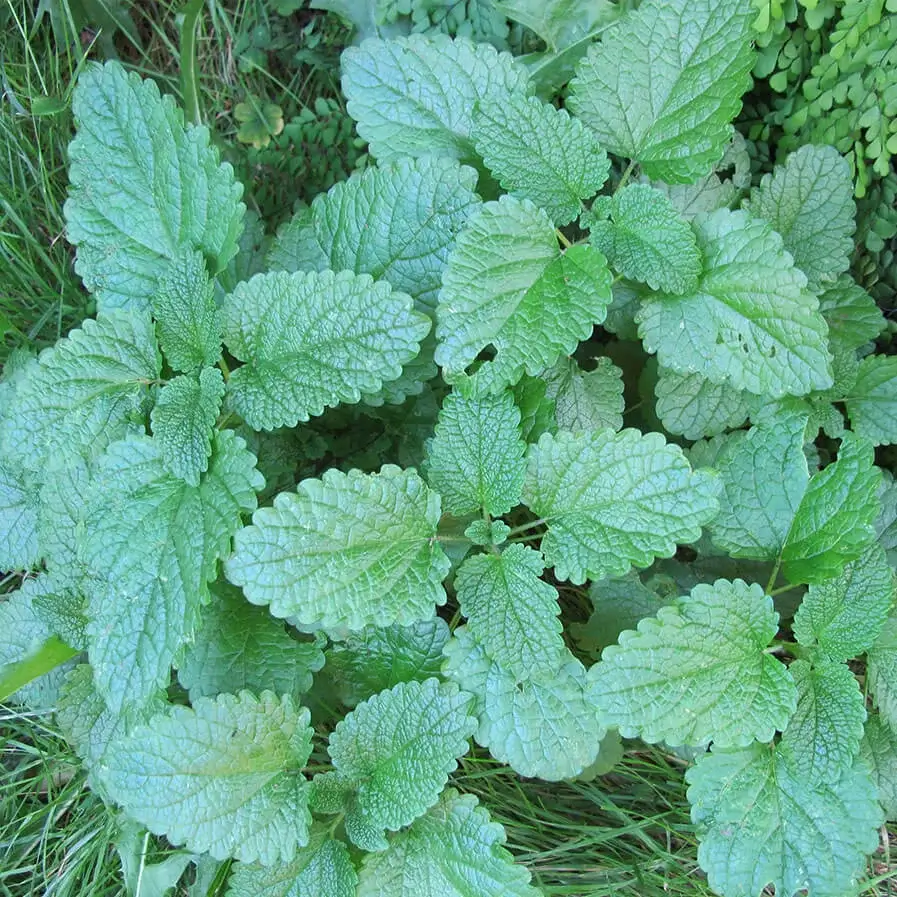
Lemon Balm
- Silver thyme
- Lavender
- Marjoram
- Sage
- Oregano
- Rosemary
- Savory
- Tarragon
- Lemon balm
- Basil
Thyme, compared to other popular herbs

Thyme
Thyme
- Growing conditions: Thyme thrives in sunny areas with well-draining soil and is drought-tolerant.
- Characteristics: Thyme has an earthy, slightly peppery, and lemony taste, with little gray-green leaves. People use it in soups, stews, roasts, and marinades.
Sage
- Growing conditions: Sage likes full sun and well-draining soil, and it’s drought tolerant.
- Characteristics: Sage has an earthy, peppery, and savory taste with fuzzy gray-green leaves. People use it in stuffing, poultry dishes, sauces, and roasted vegetables.
Rosemary
- Growing conditions: Rosemary likes full sun and well-draining soil, and it’s drought tolerant.
- Characteristics: Rosemary has a piney, resinous flavor with needle-like dark green leaves. It is popular in roasts, grilled meats, marinades, and bread.
Marjoram
- Growing conditions: Marjoram is a tender perennial herb that prefers well-drained soil and full sun. It is not frost-tolerant and needs warm temperatures to grow.
- Characteristics: Marjoram has somewhat felty green to gray-green leaves and tiny similarly colored crenelated buds with a bit of white flower. They thrive on wiry stems that form a full burst of branches, kept bushy by regularly harvesting the growth. It is crucial in Mediterranean and Middle Eastern cuisine. It is a good companion plant for many other herbs and vegetables.
Basil
- Growing conditions: Basil favors warm, sunny locations with well-draining soil and prospers in Mediterranean climates.
- Characteristics: Basil has a sweet, peppery savor with large, tender leaves varying from green to purple. It’s very popular in Italian dishes, pesto, salads, and garnish.
Cardamom
- Growing conditions: Cardamom flourishes in warm, humid climates with spotted sunlight and well-draining soil.
- Characteristics: Cardamom has a warm, citrusy taste with floral undertones. The little green pods have a papery outer shell. People use it in curries, desserts, and beverages.
Oregano
- Growing conditions: Oregano prospers in full sun with well-draining soil and is drought-tolerant.
- Characteristics: Oregano has a bold, intense, and scarcely bitter flavor with little green leaves and groups of white flowers. It’s a staple herb in Mediterranean cuisine, used in pizzas, pasta, salads, and marinades.

Thyme Allegory
Credit Alberto Conde, Kitchen in the Med
The most frequently asked questions about growing thyme
What is Thyme?
Thyme refers to the herb (dried aerial components) of certain species within the Thymus genus, which are aromatic, perennial, and evergreen herbs belonging to the mint family.
How do I prune thyme?
Trimming thyme stimulates fresh growth and branching, producing a more robust plant. Typically, the more you trim, the quicker the plant grows. Yet, throughout the growth season, avoid cutting more than a third of the plant in a month and always maintain at least five inches or 13 cm of untouched growth. Thyme also demands more frequent weeding compared to several other plants.
How do I propagate thyme?
Thyme can be propagated easily from cuttings or by rooting low-growing stems. To propagate thyme from cuttings, take 3-4 inch long cuttings and remove the lower 2 inches of leaves from the stem. Prepare small 9cm/3 inch pots with a mix of general-purpose compost and perlite, and make a few holes around the edge of the pot using a pencil or dibber. Carefully insert the cuttings into the compost until they reach the leaves. Water and place somewhere warm and shaded until roots have formed.
How long does a thyme plant live?
Thyme planted in garden soil has a lifespan of 4 to 6 years. After that, replacing the plant with a new one is best. However, thyme can be propagated easily from cuttings or rooting low-growing stems, so you can always grow new plants from the old ones.
What are the uses of thyme?
Thyme has compounds that could aid in combatting bacterial and fungal infections. It may also assist in reducing coughs and offer antioxidant benefits. While many individuals turn to thyme for ailments like cough, patchy hair loss (alopecia areata), dementia, and numerous other conditions, substantial scientific evidence to back these uses remains lacking.
How do I grow thyme?
Thyme is a resilient perennial that thrives in well-drained soil and direct sunlight. You can cultivate it from seeds or cuttings. While it needs consistent watering, avoid drenching it excessively. It can also be grown in containers.
How often should I water thyme?
Be regular, but do not overwater. Make sure the soil is dry before watering.
How do I harvest thyme?
Cut the stems just above the woody part of the plant. You can pick it throughout the growing season, but the flavor is most potent if you harvest it just before the plant flowers.
What are the different types of thyme?
There are hundreds of thyme species, but the two most frequently grown species are common Thyme (Thymus vulgaris) and mother-of-thyme, a creeping thyme (T. serphyllum). Common Thyme and its varieties are somewhat upright; creeping thyme and its types are prostrate. Thyme flower colors range from palest pink through deep purple, and the foliage varies from dark green to silver or variegated yellow.
What are the culinary uses of thyme?
Common Thyme is the most often grown and used in cooking. Its flavor enhances soups and sauces, beef, poultry, and fish. It goes well with mushrooms, vegetables, grains, and beans, making a flavorful herb butter. Some thyme, for example, lemon and caraway, each impart the flavor notes their name indicates.
Main Sources I used in This Article
RHS Royal Horticultural Society
NIH National Library of Medicine - Natinal Center for Biotechnology Information
ASPCA - American Society for the prevention of Cruelty to animals
Taylor & Francis Group
Springer Link
Essentials of medicinal and Aromatic Crops
TÜBITAK Academic Journals, Scientific and Technological Research Council of Turkey
Turkish Journal of Agriculture and Forestry
ScienceDirect
Handbook of Herbs and Spices (Second edition)
Volume 1, Woodhead Publishing Series in Food Science, Technology and Nutrition
2012
(Physical Book) Leafy Medicinal Herbs: Botany, Chemistry, Postharvest Technology and Uses
Epic Gardening
Frontiers in Nutrition
SYSTEMATIC REVIEW article
Front. Nutr., 23 May 2024
Sec. Nutrition and Metabolism
Volume 11 – 2024